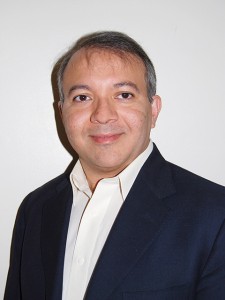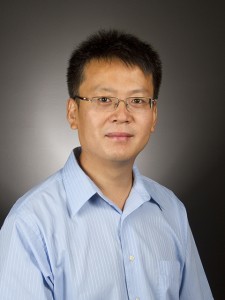
Peralta, Liu researching ways to make nuclear energy generation safer
Two Arizona State University engineers are leading research projects aimed at finding safer and more effective ways for the nation to use nuclear energy.
Yongming Liu and Pedro Peralta have each been awarded an $800,000 grant from the U.S. Department of Energy’s Nuclear Energy University Program to help develop innovative technologies and solutions to meet nuclear energy challenges.
Peralta is a professor and Liu is an associate professor of aerospace and mechanical engineering in the School for Engineering of Matter, Transport and Energy, one of ASU’s Ira A. Fulton Schools of Engineering.
Predicting nuclear fuel behavior
Peralta’s work will focus on gaining a deeper understanding of the chemical and mechanical processes taking place in the core of a nuclear reactor. That includes research to reveal more about the how various materials in a reactor core behave under extreme conditions.
He will team on the project with Ken McClellan, a technical staff member in the Materials Science and Technology Division at Los Alamos National Laboratory in New Mexico, and Peter Hosemann, an assistant professor of nuclear engineering at the University of California, Berkeley.
They will examine more precisely the ceramic fuels, gases and chemical compounds that interact in the extremely hot and radioactive environment inside a reactor core.
Radioactive fission and other processes that occur in the core can cause materials to swell, change chemical composition and react in other unstable ways. Components in a reactor system could break – or even melt – under such conditions, which would compromise the safety and efficiency of the system.
“To predict what nuclear reactors will do under certain conditions, we have to understand at the microstructure level how materials are going to behave,” Peralta says, “and you have to know precisely what is happening in each process taking place inside the reactor core to understand how to control and improve the whole nuclear energy generation process.”
That knowledge is the basis for developing models to reveal what fuels and other components will do under variable conditions. “This enables you to predict what will happen so you can prevent or respond to malfunctions and accidents,” Peralta explains.
His team wants to make it possible to perform computer simulations that eventually will accurately predict nuclear fuel behavior.
Better detection of materials damage
Like Peralta’s work, Liu will also do research to help pave the way to the next generation of nuclear energy systems.
Liu’s partner on the project is Caglar Oskay, an associate professor of civil engineering at Vanderbilt University, with expertise in computational mechanics and multiscale simulation. The research team is also working closely with Richard Wright, a staff scientist in the Materials Science and Engineering Department of the Idaho National Laboratory.
They will collaborate on developing advanced techniques to examine the properties of metal alloys used in nuclear reactors, with the goal of gaining deeper knowledge about how creep and fatigue damage initiate, propagate and interact with each other in the materials.
Creep refers to the tendency of solid materials to slowly deform due to prolonged exposure to high levels of stress or heat.
Using in situ scanning electron microscopy testing, the researchers plan to devise new materials testing techniques to provide better microscale damage analysis and prediction.
Creep and fatigue occurs in many nuclear plant components at elevated temperatures. The degradation of these components has significant impact on system safety and reliability.
“Most existing studies focus on the fatigue-dominated failure modes, but the material under operational conditions is creep dominated.” Liu explains. “Our proposed novel testing procedures will observe the damage evolution in real time under operation-like conditions and will provide support for the future design of the next-generation nuclear power system.”
There are also expected to be applications for the project’s research findings in improving the testing, analysis and prediction of damage to materials used in aircraft and related technology.
Liu and Peralta say much of what is known about nuclear energy systems is based primarily on general observations made over the years, but their work will help provide a more scientifically verifiable and comprehensive body of knowledge about nuclear energy generation and the materials and systems used to produce it.
The professors plan to give ASU graduate and undergraduate students opportunities to participate in the research projects.
Media Contact:
Joe Kullman, [email protected]
(480) 965-8122
Ira A. Fulton Schools of Engineering





































